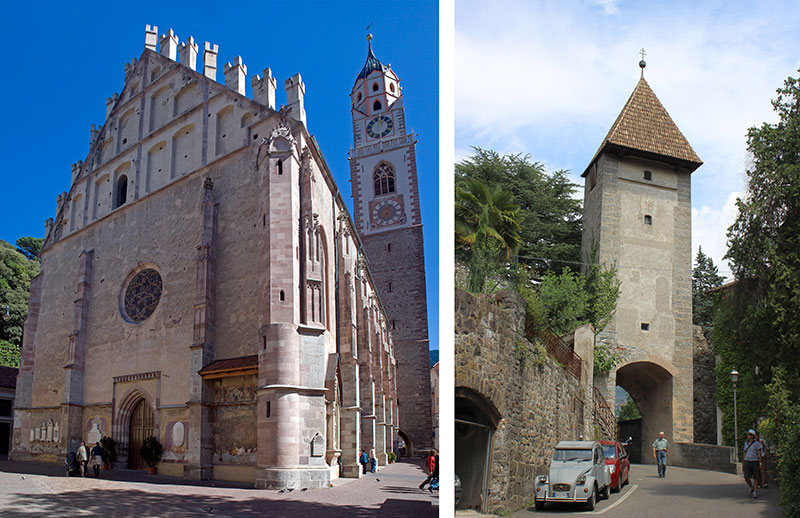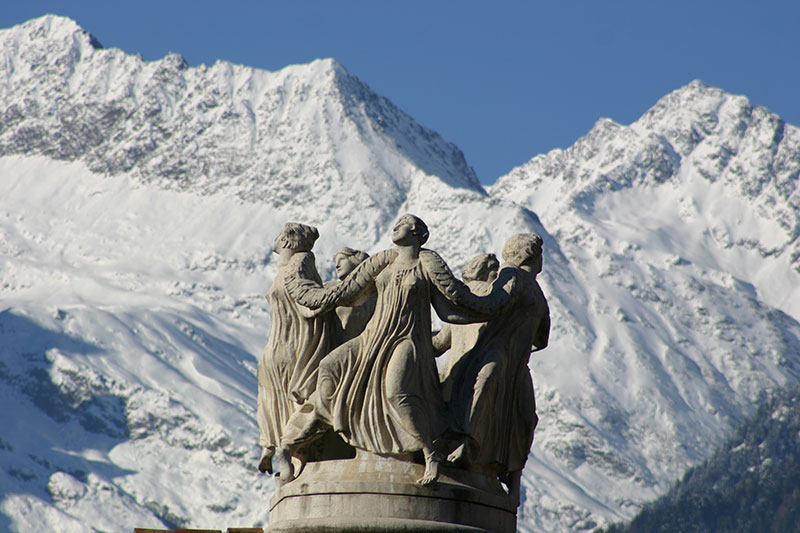
Merano is a city and comune in South Tyrol, northern Italy. Generally best known for its spa resorts, it is located within a basin, surrounded by mountains standing up to 3,335 metres (10,942 feet) above sea level, at the entrance to the Passeier Valley and the Vinschgau. Population 41,051.
Merano has an ancient tourist tradition. Many are in fact the guests of politics and culture who have spent their holidays in the city, for example the empress Sissi and the writers Franz Kafka and Gottfried Benn. This is mainly because scientists and doctors have always recommended the city for its mild and almost Mediterranean climate and for the quality of the air. In 1914 the Kurhaus was enlarged , the work of the architect Friedrich Ohmann who was linked to the Viennese Secession.
Considered a health resort since the nineteenth century, Merano was initially oriented towards tourism for the elderly , thanks to the mild climate and the quiet that characterize it. In the twentieth century and particularly in the last two decades, this trend has changed mainly thanks to a more varied offer and the arrival of national and international tourism that has reached and surpassed that of the German-speaking countries, significantly reducing the average age of its visitors.

In the second half of the nineteenth century Merano became an important health resort and holiday resort of the Austro-Hungarian Empire , thanks also to the railway connection inaugurated in 1881 and completed with the railway station designed by vonChabert in 1905. Consequently the city expands outside the perimeter of the walls on urban planning models of Viennese and Salzburg derivation and with the contribution of the German urban planner
Placename
Both the German (Meran) and the Italian (Merano) names for the city are used in English. The Ladin form of the name is Maran. The official name of the municipality (comune) is Stadtgemeinde Merano in German and Comune di Merano in Italian (both are in official use).
Main sights

Among the city's landmarks are the medieval city gates such as the Vinschgauer Tor, Passeirer Tor, and the Bozener Tor. Also belonging to the fortifications is the medieval Ortenstein tower, popularly called Pulverturm (lit. "powder tower").
The main churches are the Gothic St. Nicholas' Church and the St. Barbara's Chapel, both dating to the 15th century. Also dating to this period is the Princely Castle (Landesfürstliche Burg), which was a residence of Archduke Sigismund of Austria.
The city saw further development as it became increasingly popular as a spa resort, especially after Empress Elisabeth of Austria started visiting. Dating from the 19th century are the Civic Theatre, the Kurhaus and the Empress Elisabeth Park. Also famous are the arched Wandelhalle promenades along the river. After the annexation of the city by Italy in 1919, the Fascist authorities constructed the new city hall in the 1920s.

Outside the city is Trauttmansdorff Castle and its gardens. Located there is the Museum of Tourism, which was opened in the spring of 2003 and shows the historical development of tourism in the province. Tirol Castle is also close by.
History
The area has been inhabited since the 3rd millennium BC, as shown by the presence of menhirs and other findings. The story of the city proper began in 15 BC when the Romans occupied the Adige valley founding a road station, Statio Maiensis.

In Roman times the area of present-day Merano is called Maia and is located on the border between the province of Rezia and the Regio X Venetia et Histria , on the northern edge of the municipium of Trento . In Late Antiquity there develops Maiense castrum , a fortified settlement located from the fortress of the Castel San Zeno. In the chapel of the castrum , St. Valentine of Rezia (at the end of the 5th century ) and St.Corbinian of Freising (around 730 ).
The settlement was first mentioned in an 857 deed as Mairania. The Counts at Castle Tyrol elevated Merano to the status of a city during the 13th century and made it the capital of their County of Tyrol. After the county had been handed over to the Habsburg dynasty in 1363 upon the abdication of Margaret, Countess of Tyrol, in 1420 Duke Friedrich IV of Austria moved the Tyrolean court to Innsbruck. Though Merano remained the official capital until 1848, it subsequently lost its predominant position and almost all its importance as an economic hub across the roads connecting Italy and Germany. The important mint was also moved to Hall in 1477.
In 17th-century Latin, the city was called Meranum.Other archaic names are Mairania (from 857 AD) and an der Merano (from the 15th century).
Modern history
The Tyrolean Rebellion of 1809 against the French occupation drew attention again to Meran. In that year, on the Küchelberg above the city, a peasants' army eked out a victory against the united French and Bavarian forces before their revolt was finally crushed. After World War I, under the Treaty of Saint-Germain-en-Laye Merano became part of the Kingdom of Italy with the rest of the southern part of the former Cisleithanian crown land of Tyrol.
After the First World War, Merano, like the whole southern part of Tyrol, was annexed to Italy
During the Nazi occupation of the region in 1943–5, the Meranese Jewish population was almost completely deported and murdered within concentration camps.
Climate
Merano is on the borderline between several climates. Officially, it has an oceanic climate (Cfb). However, it is close to being humid subtropical (Cfa) due to the mean temperature in July being just under 22 °C; even on those terms, the overnight lows in the winter bring the mean temperatures low enough for the city as a whole to have continental (Dfa/Dfb) influences with more distinct seasons.
The average daily temperatures in summer in Merano lie between 27 and 30 °C, while at night temperatures usually drop to between 12 and 15 °C. The average daily temperatures in winter lie between 6 and 10 °C, while at night temperatures usually drop to between -4 and -2 °C. The wettest month is August with 96 mm, while the driest is February with only 25 mm. This data was measured at the weather station Meran/Gratsch at an altitude of 333 metres between 1983 and 2017.
Merano railway station

Merano is a popular tourist destination especially for Germans and Italians. In the summer, there are concerts on the promenade almost daily, and there are fine walks around the city and in the surrounding hills, not least "Merano 2000", where there is also skiing in winter. The city is reachable with the railway Bolzano-Meran, which continues to the Vinschgau Railway Meran-Mals.
Linguistic distribution: According to the 2011 census, 50.47% of the resident population spoke German as mother language, 49.06% Italian, and 0.47% Ladin.
Information from Wikipedia. Added original content coming soon.
